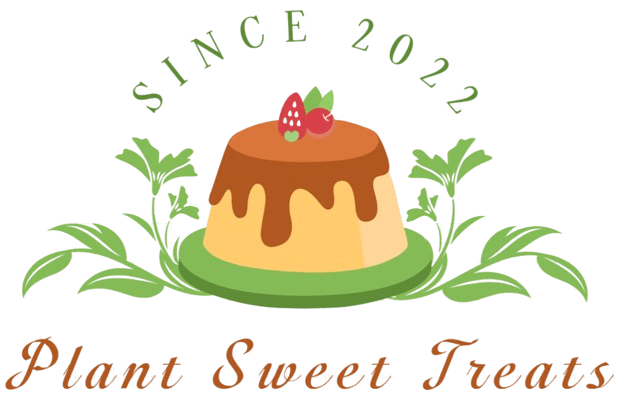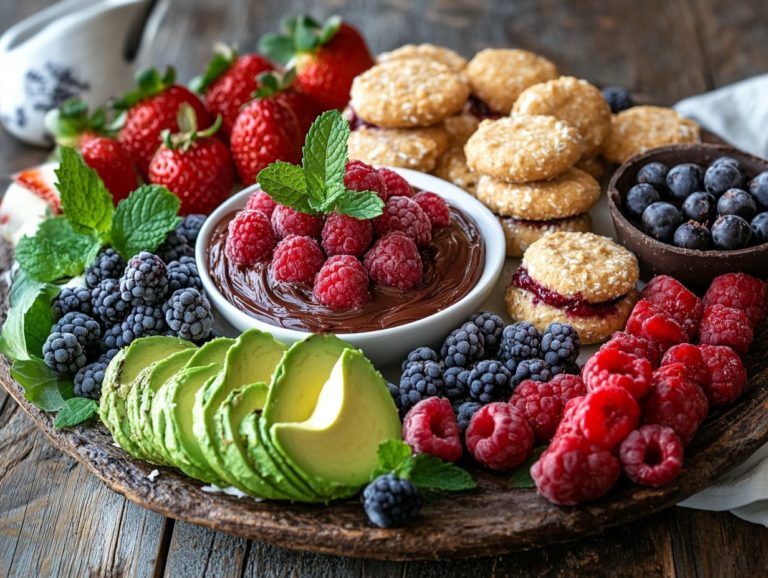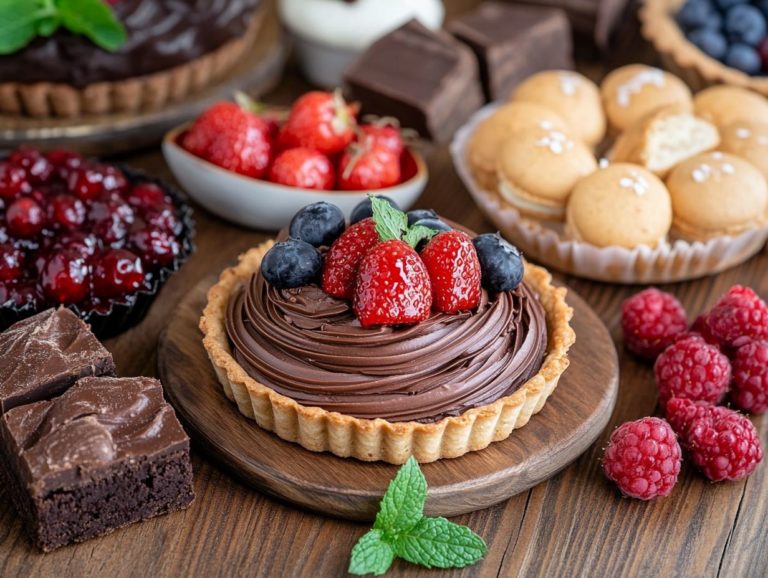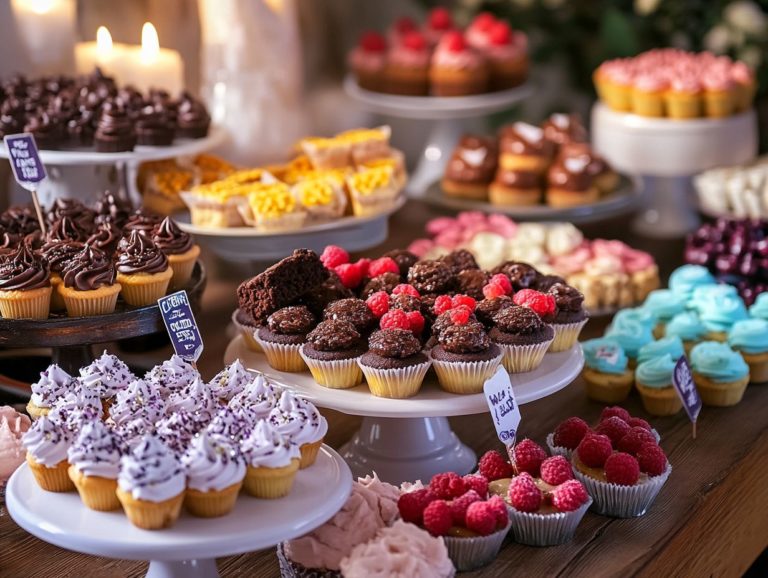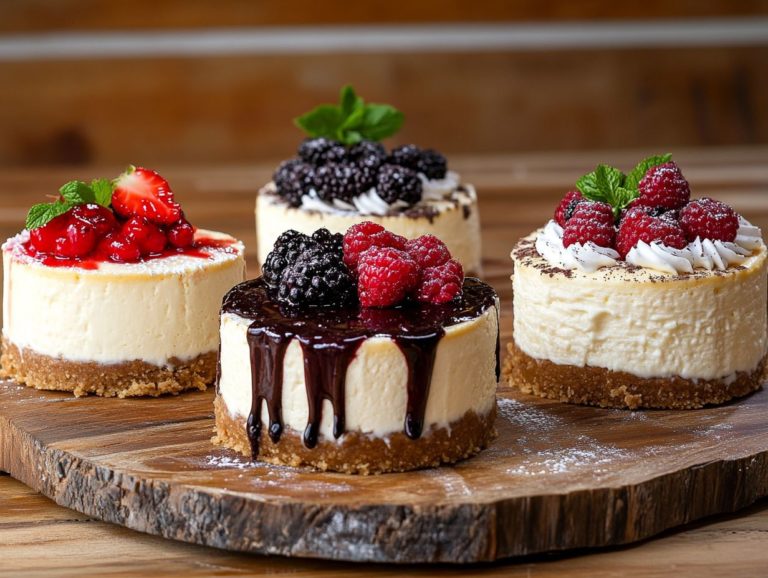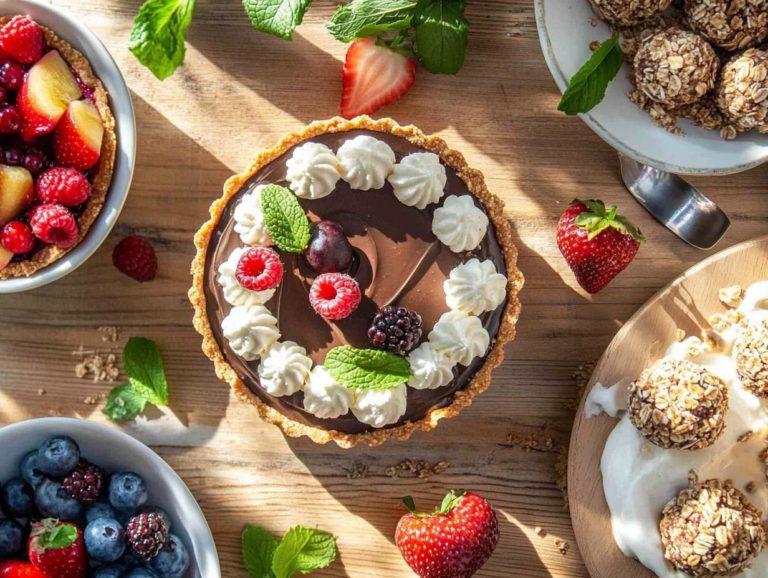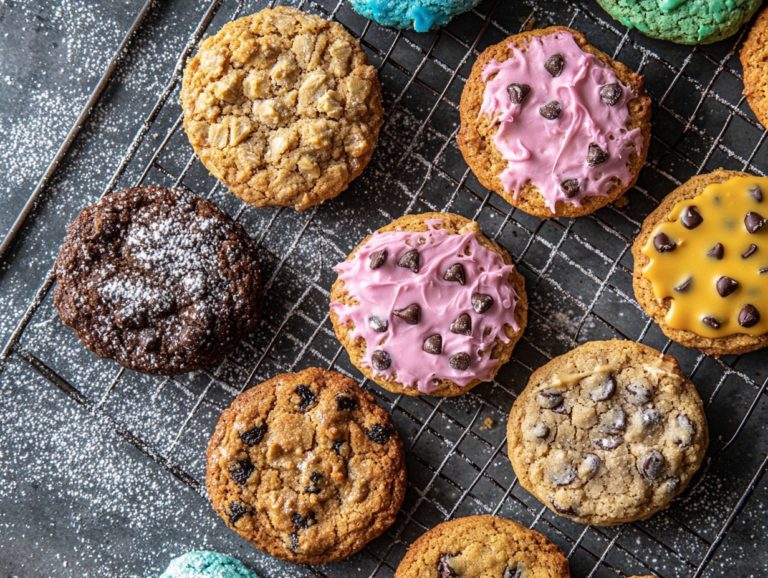How to Make Gluten-Free Pancakes and Waffles
Are you craving pancakes or waffles but feeling concerned about gluten? Rest assured, you re in good company! Many individuals choose gluten-free diets for a variety of reasons, whether it s due to celiac disease, gluten sensitivity, or a wheat allergy.
Indulging in delicious homemade pancakes and waffles without gluten is more attainable than you may realize.
This article delves into the advantages of adopting a gluten-free lifestyle, the essential ingredients you’ll need, and straightforward cooking instructions to create fluffy, mouthwatering gluten-free pancakes and waffles. You ll also find valuable tips to ensure your breakfast experience is nothing short of exceptional!
Contents
- Key Takeaways:
- Why Choose Gluten-Free Pancakes and Waffles?
- 3. Gluten-Free Diet for People with Wheat Allergy
- What Are the Ingredients for Gluten-Free Pancakes and Waffles?
- 1. Gluten-Free Flour
- 2. Eggs
- Craft Delicious Gluten-Free Pancakes and Waffles at Home!
- What Are Some Tips for Making the Perfect Gluten-Free Pancakes and Waffles?
- 1. Let the Batter Rest
- 2. Use a Non-Stick Pan or Waffle Iron
- 3. Don’t Overmix the Batter
- 4. Experiment with Different Flavors and Toppings
- Frequently Asked Questions
- What ingredients do I need to make gluten-free pancakes and waffles?
- Can I use regular flour in my gluten-free pancake and waffle recipe?
- How do I make sure my pancakes and waffles are completely gluten-free?
- Can I make gluten-free pancakes and waffles ahead of time?
- Why do my gluten-free pancakes and waffles sometimes turn out dense and dry?
- Can I use almond flour or coconut flour in my gluten-free pancake and waffle recipe?
Key Takeaways:
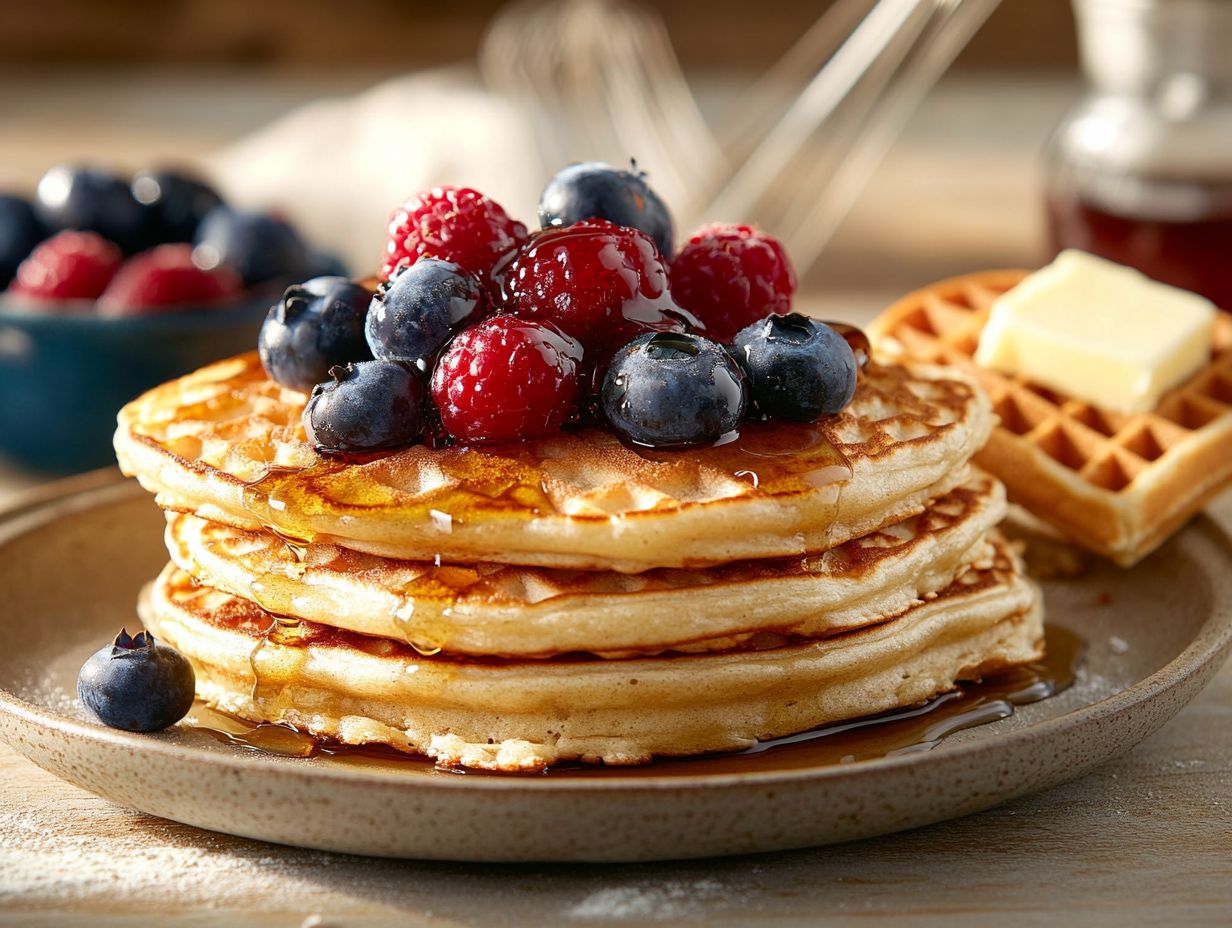
- Gluten-free pancakes and waffles are a great choice for people with celiac disease, gluten sensitivity, or wheat allergy.
- The key ingredients for gluten-free pancakes and waffles include gluten-free flour, eggs, milk, baking powder, and oil or butter. You can also use egg substitutes and non-dairy milk alternatives for a dairy-free or vegan option.
- To make perfect gluten-free pancakes and waffles, let the batter rest, use a non-stick pan or waffle iron, and don’t overmix. Be creative with flavors and toppings like berries, chocolate chips, or maple syrup.
Why Choose Gluten-Free Pancakes and Waffles?
Opting for gluten-free pancakes and waffles transcends mere trendiness; it becomes an essential dietary choice for many, especially for those grappling with celiac disease, gluten sensitivity, or wheat allergies.
These delightful homemade alternatives enable you to savor the fluffiness of pancakes and waffles crafted from gluten-free flour, all while prioritizing your health. Using a pancake mix or waffle mix can make the process quick and easy. This ensures you spend more time enjoying your meal.
By embracing gluten-free recipes featuring reputable brands like gfJules, Bob’s Red Mill, or King Arthur’s, you can swiftly whip up meals that cater to every member of the family. Everyone can indulge without compromise.
1. Gluten-Free Diet for People with Celiac Disease
For those with celiac disease, adhering to a gluten-free diet is not just a preference; it’s a vital necessity to prevent serious health complications. This makes gluten-free pancakes and waffles essential breakfast staples in your culinary repertoire.
This strict dietary requirement exists because even trace amounts of gluten can provoke harmful reactions in your intestines, leading to a spectrum of symptoms ranging from stomach problems to long-term damage.
The significance of maintaining a gluten-free lifestyle cannot be overstated; it alleviates discomfort while also enhancing your overall health and well-being.
A delightful array of gluten-free pancake and waffle recipes awaits you, utilizing safe ingredients like almond flour, banana, or even oats. Consider adding vanilla or vanilla pudding to enhance the flavors, so you can relish a satisfying breakfast experience without any risk.
2. Gluten-Free Diet for People with Gluten Sensitivity
Gluten sensitivity, while not as severe as celiac disease, can still bring about discomfort and health concerns. This makes gluten-free pancakes and waffles an excellent choice for anyone navigating this condition.
If you re experiencing gluten sensitivity, you might encounter symptoms like bloating, fatigue, headaches, and digestive issues, all of which can greatly affect your daily life.
The good news is that adopting a gluten-free diet can help ease these pesky symptoms. By cutting out gluten-rich foods and embracing delicious alternatives, such as gluten-free pancakes and waffles, you can enjoy satisfying meals without the discomfort that usually follows.
Consider recipes that utilize almond flour, coconut flour, or quinoa these options not only meet your dietary needs but are also incredibly tasty. Picture light, fluffy pancakes adorned with fresh berries or crispy waffles drizzled with maple syrup.
Satisfying your cravings while sticking to a gluten-free lifestyle is not just possible; it’s downright delightful. You can also explore using vanilla, vegetable oil, or even water as additional ingredients to achieve perfect pancakes and waffles.
Try these recipes today and enjoy a gluten-free breakfast that’s both satisfying and safe! Embrace the joy of gluten-free cooking and treat yourself to these delightful breakfast options.
3. Gluten-Free Diet for People with Wheat Allergy
If you have a wheat allergy, it s important to avoid wheat and gluten-containing products. This makes gluten-free pancakes and waffles not only safe for you but also delightful choices for a healthy breakfast.
You may face severe allergic reactions, including hives, swelling, and even anaphylaxis a severe allergic reaction that can be life-threatening if you consume wheat. If you have gluten sensitivity, you might not experience such acute responses, but digestive issues, fatigue, and discomfort can still follow a gluten-laden meal. Understanding this difference is crucial for managing your diet successfully!
Fortunately, gluten-free alternatives let you enjoy your favorite breakfast staples without the associated risks. By using ingredients like almond flour or coconut flour, you can whip up fluffy pancakes and crispy waffles that tantalize your taste buds while adhering to safe eating practices. For travelers, options like Air B&B or hotel kitchenettes make it easier to maintain a gluten-free diet on the go.
What Are the Ingredients for Gluten-Free Pancakes and Waffles?
Crafting delectable gluten-free pancakes and waffles demands a thoughtful blend of essential ingredients that honor dietary needs while delivering fluffy textures and delightful flavors. The cornerstone of your creation is high-quality gluten-free flour, which can be a harmonious mix of flours such as rice, almond, or coconut, each contributing its unique texture and taste.
Don t overlook the importance of eggs. If you prefer a vegan alternative, applesauce serves as a great substitute. Baking powder is essential for achieving that light, airy quality. You have a world of milk options at your fingertips, including non-dairy choices that allow you to tailor your breakfast recipe to perfection. Adding milk powder can also enhance the richness of your batter.
1. Gluten-Free Flour
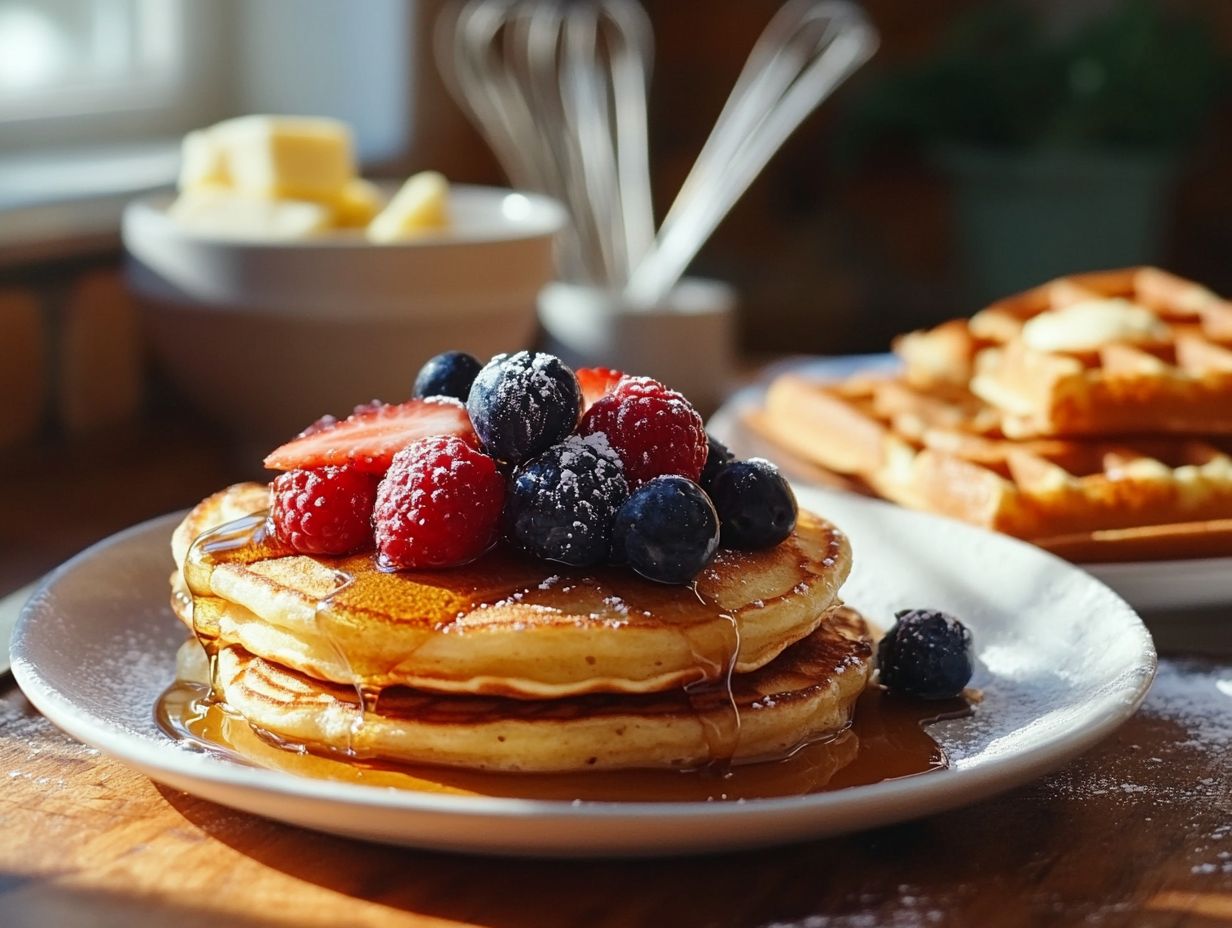
Gluten-free flour serves as the essential foundation for any gluten-free pancake or waffle recipe, delivering the structure and texture that traditional wheat flour typically provides.
Selecting the right gluten-free flour blend can dramatically enhance the flavor and fluffiness of your beloved breakfast treats. Consider options like gfJules, Bob’s Red Mill, and King Arthur’s, each offering unique blends tailored to various preferences and dietary requirements.
For example, Bob’s Red Mill features a versatile gluten-free all-purpose flour that seamlessly substitutes traditional flour in both savory and sweet dishes. On the other hand, gfJules presents a specially formulated blend ideal for crafting light and airy pancakes. Meanwhile, King Arthur’s, renowned for its exceptional quality, offers a blend that combines a variety of gluten-free grains, ensuring a well-rounded taste.
When selecting the right flour, take into account the specific recipe needs and your personal palate to achieve pancake and waffle perfection!
2. Eggs
Eggs are critical for crafting gluten-free pancakes and waffles. They bring moisture and play a crucial role in binding, ensuring that your pancakes turn out fluffy and rise beautifully during cooking.
Beyond enhancing texture, eggs provide the structure and richness that can often be difficult to find in gluten-free baking. They help achieve that sought-after airy quality, allowing your breakfast creations to reach new heights rather than falling flat.
If you need alternatives perhaps due to egg allergies or a commitment to a vegan lifestyle consider using applesauce as a superb substitute. This natural fruit puree not only maintains the necessary moisture but also adds a touch of sweetness, enabling you to whip up delightful gluten-free recipes without sacrificing flavor or texture. You can also add vanilla to elevate the taste.
Try making gluten-free pancakes today and enjoy a delicious, safe breakfast!
3. Milk or Non-Dairy Alternatives
Choose the perfect milk whether you opt for dairy or one of the enticing non-dairy alternatives to profoundly influence the flavor and texture of your gluten-free pancakes and waffles.
With a delightful array of milk options at your disposal, including almond, soy, coconut, oat, and cashew, your vegan recipes can achieve delicious and distinctive tastes. Non-dairy milks introduce diverse textures and can elevate the flavor profile of your breakfast favorites.
For instance, almond milk offers a light touch, while coconut milk provides a rich, creamy texture ideal for sweet batters. Another option is soy milk, known for its versatility in both sweet and savory recipes.
As you select the ideal milk for your gluten-free creations, consider the sweetness and thickness of each option. Coconut milk, rich and decadent, pairs beautifully with sweeter batters, while unsweetened almond milk offers a versatile, lighter touch. Experimenting with different milk types leads to delightful culinary discoveries on your cooking journey. Whether you like your pancakes and waffles fluffy or crispy, choosing the right milk can make all the difference.
4. Baking Powder
Baking powder is a critical leavening agent in your gluten-free pancakes and waffles, ensuring they rise beautifully and achieve that desired fluffy texture that delights every palate.
Its primary role is to release carbon dioxide gas upon encountering moisture and heat, creating the bubbles that expand during cooking. This is crucial in gluten-free baking because gluten usually gives structure and stability, leading to denser, flatter results. For quick and easy prep time, having a quality baking powder on hand is essential.
The precise amount of baking powder you use can truly make a world of difference; too much can impart an unpleasant metallic taste, while too little may leave your batter woefully flat.
Mastering the art of measuring and incorporating this ingredient is essential for anyone looking to elevate their gluten-free breakfast creations to new heights. Consider trying Bobs Redmill or King Arthurs for reliable gluten-free baking results.
5. Oil or Butter
Oil or butter plays a crucial role in gluten-free pancake and waffle recipes, infusing them with richness and moisture that elevates both flavor and texture. These fats are essential ingredients in any gluten-free recipe to achieve the best results.
As you explore your options for these delightful creations, consider using vegetable oil. Its neutral taste allows the other ingredients to shine, ensuring they aren t overshadowed. If you want to venture beyond the basics, oils like coconut or avocado can introduce unique flavors and health benefits, subtly shifting the profile of your final dish.
For those who prefer butters, alternatives such as almond or cashew butter offer a creamy consistency while adding a nutty essence that beautifully complements both sweet and savory variations. Each ingredient you choose influences the taste and plays a significant role in the batter’s consistency, which is essential for achieving that perfect fluffy texture. This can make your pancakes and waffles as delightful as an Air B&B breakfast experience.
Craft Delicious Gluten-Free Pancakes and Waffles at Home!
Creating gluten-free pancakes and waffles in the comfort of your home is a delightful experience that combines simplicity with the joy of good ingredients. Gluten-free baking has never been easier. Begin by assembling your gluten-free pancake mix or the individual components we ve talked about, ensuring you have all that s necessary for a splendid breakfast. You can find options like gfJules or make your own mix.
Once you have everything in place, the cooking instructions will guide you through the process of mixing, pouring, and cooking these fluffy delights, allowing you to whip them up in no time. This makes them an ideal choice for a quick yet satisfying meal.
We encourage you to share your pancake or waffle creations on social media with the hashtag #GFDelights to foster community engagement!
1. Mixing the Dry Ingredients
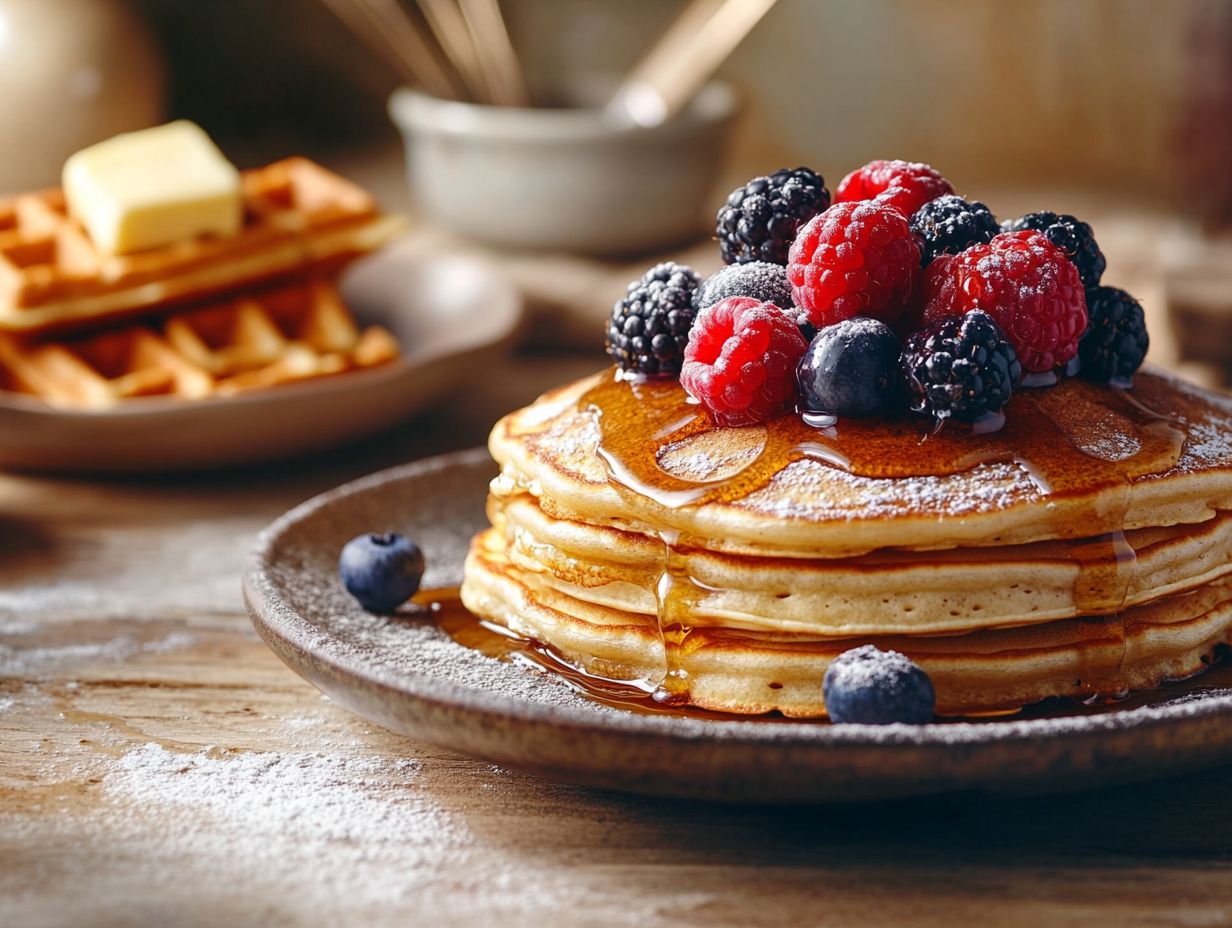
Your journey to crafting the perfect gluten-free pancakes or waffles begins with a meticulous mixing of the dry ingredients. For easy pancakes, start by combining gluten-free flour and baking powder, ensuring an even distribution that will play a crucial role in achieving the desired texture.
It’s essential to add other dry components like salt and sugar to elevate the overall flavor profile. For optimal results, reach for a whisk or sifter, to blend these ingredients. This technique aerates the mixture beautifully and prevents any pesky clumps from forming.
Precision is key here. Using a kitchen scale will help you measure accurately, ensuring consistency in your final product. Keep in mind your ultimate goal: a harmonious blend that yields light and fluffy pancakes or waffles. So, take your time to combine everything thoroughly and resist the urge to cut corners that could jeopardize your delicious outcome. Try brands like gfJules for consistent results in your gluten-free recipe.
2. Adding the Wet Ingredients
After mixing your dry ingredients, the next crucial step is to carefully introduce the wet ingredients think eggs or egg substitutes, along with milk or non-dairy milk to achieve that perfect pancake or waffle consistency.
This process guarantees a smooth batter and significantly impacts the texture and flavor of your final creation. When you choose ingredients like whole milk, almond milk, or even oat milk, you ll discover that the taste and richness can differ dramatically. Opt for dairy-free options to cater to diverse dietary needs.
Using egg substitutes such as flaxseed meal or applesauce can offer varying moisture levels and how well it holds the ingredients together, which ultimately influences the fluffiness and density of your pancakes or waffles.
It s essential to mix gently until just combined, ensuring a light and airy result without overworking the batter because nobody wants tough pancakes or waffles. For more tips on this, you can refer to gluten-free recipe guides.
3. Cooking the Pancakes and Waffles
Cooking pancakes and waffles is the final touch that transforms your gluten-free breakfast into a culinary delight. Pay careful attention to heat and timing to achieve those fluffy, golden-brown masterpieces. Whether you’re making pancakes or waffles, achieving the right texture is crucial.
Start by preheating your skillet or waffle iron to a medium temperature, typically around 350 F (175 C). This ensures it’s hot enough to produce a delightful crust. For pancakes, pour the batter onto the cooking surface and watch for small bubbles forming; that s your signal to flip them. Waffles, on the other hand, require a bit more patience, so watch for a steady release of steam to gauge when they re ready.
Don t hesitate to experiment try infusing your batter with flavors like vanilla or cinnamon, and get creative with your toppings. Fresh fruits, a drizzle of maple syrup, or even a sprinkle of nuts can elevate your breakfast to new heights of deliciousness!
What Are Some Tips for Making the Perfect Gluten-Free Pancakes and Waffles?
- Allow the batter to rest for better texture.
- Select the right cooking equipment.
- Be attentive to your mixing techniques.
- Explore a variety of flavors and toppings think luscious berries, decadent chocolate chips, and rich maple syrup.
Try these tips today and elevate your breakfast game!
1. Let the Batter Rest
Allowing the batter to rest is essential when crafting gluten-free pancakes and waffles. This straightforward yet vital step enables the gluten-free flour to absorb moisture and the baking powder to activate, yielding a wonderfully fluffy result.
Resting not only enhances the texture but also enriches the flavor profile of your finished creation. By permitting the ingredients to meld together, your pancakes or waffles will emerge with a depth of flavor that significantly elevates your breakfast experience.
For the best results, aim to let the batter sit for at least 15 to 30 minutes. This brief pause allows air bubbles to form, contributing to a lighter, airy structure that will delight anyone at your breakfast table.
If you have the time, allowing the batter to rest for about an hour can further enhance its overall quality, transforming your meal into a gourmet experience.
2. Use a Non-Stick Pan or Waffle Iron
Using a non-stick pan or waffle iron is essential for your gluten-free pancakes and waffles. This choice prevents sticking and ensures even cooking, while preserving the integrity of your delightful homemade breakfast.
When striving for that perfect golden-brown crust and fluffy center, the cooking equipment you choose plays a pivotal role in the final outcome. A high-quality non-stick pan minimizes the risk of batter clinging to the surface, allowing for a seamless flip and uniform cooking.
If you re opting for a waffle iron, remember to preheat it adequately before pouring in the batter. This guarantees even heat distribution and a superior texture.
To enhance your cooking experience, consider lightly greasing the non-stick surface with oil or cooking spray. This simple step can elevate the texture of your breakfast while making cleanup a breeze.
Always ensure your equipment is well-maintained, as this significantly contributes to the longevity and effectiveness of your trusted kitchen tools.
3. Don’t Overmix the Batter
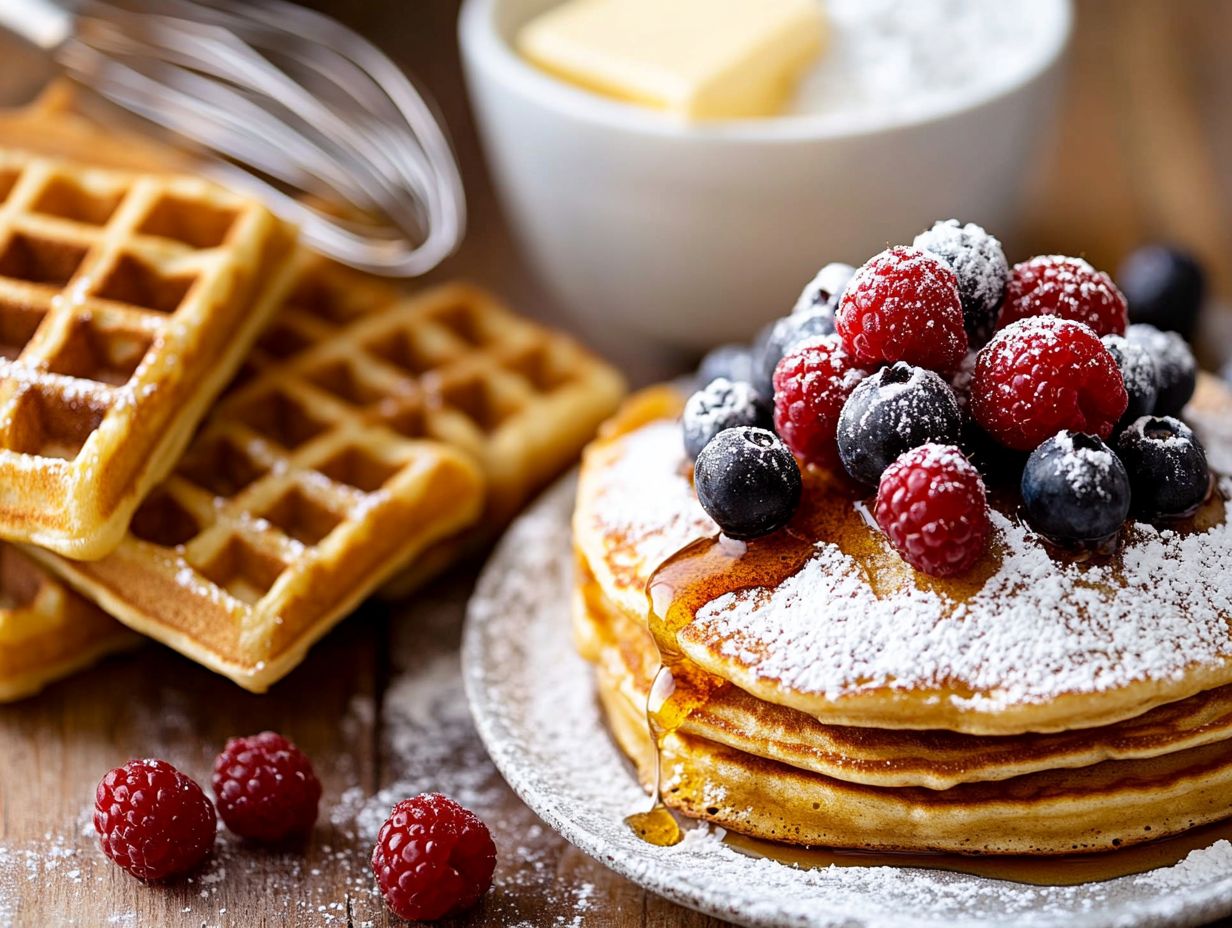
One of the most essential tips for achieving perfect gluten-free pancakes and waffles is to avoid overmixing. Overmixing can lead to dense and rubbery results instead of the light and fluffy textures you desire.
This is particularly true when working with gluten-free flours, which behave quite differently than their gluten-containing counterparts. Since gluten responsible for elasticity and structure in traditional baking is absent in gluten-free options like almond or coconut flour, mixing too vigorously activates different starches and proteins. This can cause the mixture to become overly cohesive and tough.
To achieve that ideal texture, mix just until the ingredients are combined. This approach allows for a tender crumb and an enjoyable bite, ensuring your final product remains airy and delightful.
4. Experiment with Different Flavors and Toppings
Get ready to transform your pancakes and waffles into a gourmet breakfast experience! Experimenting with a medley of flavors and toppings allows you to tailor each serving to your palate.
Imagine drizzling warm, rich maple syrup over a stack that bursts with the sweetness of fresh blueberries or strawberries. For those moments when you desire a touch of indulgence, adding chocolate chips offers a delightful melty surprise with each bite.
You can even try different variations like easy pancakes or fluffy waffles. Consider incorporating crushed nuts for a satisfying crunch or topping it all off with a dollop of whipped cream to create an irresistible treat.
With these diverse ingredients at your disposal, the possibilities are truly limitless, inviting you to unleash your creativity while savoring a breakfast that perfectly caters to gluten-free needs. Don’t hesitate to explore various brands and recipes to find what works best for you.
Frequently Asked Questions
What ingredients do I need to make gluten-free pancakes and waffles?
To make gluten-free pancakes and waffles, you will need gluten-free flour (such as gfJules, Bob’s Red Mill, or King Arthur’s), baking powder, salt, eggs, milk (or a dairy-free alternative), oil, and any desired flavors or mix-ins (like chocolate chips or blueberries).
Can I use regular flour in my gluten-free pancake and waffle recipe?
No, regular flour contains gluten, which isn t suitable for a gluten-free diet. Always ensure you use a gluten-free flour blend for the best results in your pancakes and waffles!
How do I make sure my pancakes and waffles are completely gluten-free?
In addition to using gluten-free flour (like gfJules or Bob’s Red Mill), it is important to check all your ingredients, including baking powder and any mix-ins, to ensure they are also gluten-free. It s wise to use different cooking utensils and equipment to prevent mixing gluten-free ingredients with those containing gluten.
Can I make gluten-free pancakes and waffles ahead of time?
Yes, you can prepare gluten-free pancakes and waffles in advance. Store them in an airtight container in the refrigerator for 2-3 days or freeze them for up to 3 months.
Just reheat in a toaster or oven before serving. This option is great for Air B&B hosts wanting to provide gluten-free breakfasts.
Why do my gluten-free pancakes and waffles sometimes turn out dense and dry?
This could be due to using too much gluten-free flour or overmixing the batter. To avoid this, measure your flour accurately and only mix until the ingredients are just combined.
Additionally, consider using a blend like King Arthur’s for better texture.
Can I use almond flour or coconut flour in my gluten-free pancake and waffle recipe?
Yes, you can use alternative flours like almond or coconut flour in your gluten-free pancake and waffle recipe. You might need to change the recipe by using less flour and adding more liquid, since these flours absorb moisture differently than regular flour. This is an excellent option for those who are also looking for dairy-free recipes.
